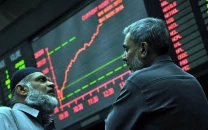Rupee makes spectacular recovery after free-fall, to remain volatile
Crackdown on dollar smuggling and hoarding dismantled black markets in border areas, reversing rupee’s fall

Pakistani currency has made a spectacular recovery after a free-fall during the government led by the Pakistan Democratic Movement. The caretaker setup successfully reversed the unabated appreciation of the greenback through a slew of administrative measures, including a crackdown on its smuggling.
The rupee is, however, projected to remain volatile in the inter-bank market by the end of current fiscal year on June 30, 2024 due to a potential uptick in the dollar demand to pay for imports and repay the maturing debt, according to reports of research houses.
Currency dealers anticipated that the rupee would close at slightly above Rs280/$ by the end of December 2023. It ended at Rs282.73/$ on Tuesday (December 26). The depreciation mainly stemmed from high political uncertainty in the last seven and a half months of the PDM government.
The currency hit an all-time low at slightly above Rs307/$ in the first week of September in the backdrop of speculation that the caretaker setup had been tasked with letting the currency depreciate further. The speculation, however, proved wrong as the caretaker setup, led by Prime Minister Anwaarul Haq Kakar, ordered a crackdown on dollar smuggling, mainly to Afghanistan, as well as hoarders, dismantled black markets in border areas and eliminated the illegal Hawala-Hundi network.
The strict action helped to increase the inflow of foreign currencies through official channels including workers’ remittances and export proceeds, which propped up the rupee to Rs277/$ by late November 2023. It represented a handsome recovery of 11%, or around Rs30, from the record low of Rs307/$.
In a comprehensive report titled “Pakistan Investment Outlook 2024”, Taurus Securities, a subsidiary of the National Bank of Pakistan (NBP), Director Research Mustafa Mustansir said “we expect the US dollar to reach Rs296.6 by the end of FY24, averaging Rs291.4/$ for FY24.”
“Our estimates account for the likely surge in the dollar as substantial debt repayments approach early next year as well as in the run-up to elections. Also, aggressive monetary easing may put pressure on the rupee,” he said.
Arif Habib Limited economist Sana Tawfik said the other day that her research house was of the view that the rupee would depreciate by the end of June 2024 because of increased demand for the dollar for high import payments.
The government’s resolve to achieve a moderate economic growth of 2-3% in FY24 and a potential reduction of seven percentage points in the central bank’s policy rate in the next one year to 15% would lead to a pickup in demand for the greenback and ramp up pressure on the rupee.
Developments in 2023
Treasury firm Tresmark said last week that despite all odds the rupee had strengthened by more than Rs3 to Rs282.50/$ in the past one month.
A big reason was the State Bank of Pakistan’s (SBP) breakeven current account policy, prompting banks to strictly match outflows with inflows. Owing to this, the current account was mildly positive last month.
Also, Pakistan’s foreign exchange reserves remained largely stable around $12 billion (SBP-held reserves stood slightly below $7 billion) compared to $12.9 billion in July, in spite of a $1.16 billion current account deficit (CAD) in the first five months of FY24.
Read Foreign currency inflow hopes aid rupee’s uptrend
The practice of zero CAD comes at a huge cost, which is zero economic growth. However, the current setup is prioritising stability over growth while trying to cool down inflation, according to Tresmark.
Forex obligations of $24 billion for the next seven months are worrisome. As raising funds from international markets is quite difficult, it will continue to pose challenges.
Taurus Securities’ Mustansir said that the rupee depreciated to the all-time low at Rs307.1/$ in the inter-bank market (down 36% from the closing level in December 2022) amid growing macroeconomic and political uncertainty. Following that, the difference between inter-bank and open market currency rates widened to 9%.
However, subsequent actions by the SBP and other authorities helped curb the unofficial flow of dollars, resulting in the narrowing of difference to within the IMF-prescribed range of 1.25% and an increase in the official flow of dollars.
Later, the improving external outlook for Pakistan and the decline in political and macroeconomic uncertainty helped the rupee to recover 11% against the dollar.
Moreover, the rupee seems to be fairly priced on the Real Effective Exchange Rate (REER) index hovering around 98 these days. Any level above 100 will be worrisome when imports become cheaper and exports uncompetitive.
Since the approval of the International Monetary Fund’s (IMF) standby arrangement (SBA) of $3 billion in late June, Pakistan’s external outlook has improved significantly. Under the SBA, Pakistan was able to immediately secure $1.2 billion along with financial support from friendly countries such as Saudi Arabia and the UAE.
Following the SBA, Pakistan also got funding from the World Bank and Asian Development Bank (ADB).
In addition, the IMF prescribed stringent conditions and benchmarks under the loan programme, which resulted in landmark reforms of exchange companies along with the crackdown on dollar hoarding and smuggling. Consequently, the rupee recovered to Rs277/$ by mid-October as official inflows improved.
Import restrictions were also lifted as part of the SBA commitments, breathing fresh life into the manufacturing sector. The SBP has allowed banks to manage their foreign exchange liquidity needs (mainly settling letters of credit) from their own sources, ie, export receipts and remittances.
Furthermore, the SBP has told banks to process dividend and profit repatriation requests of multinational companies. So far in FY24, the dividend and profit repatriation stands at $485 million, more than the repatriation in the entire FY23.
Foreign exchange reserves have improved in recent months in the wake of higher remittances from official channels, which came when the difference between inter-bank and open market currency rates dropped significantly and CAD contracted 64%.
In addition, Pakistan has continued to make timely payments for Eurobonds. According to the SBP, $5.4 billion worth of debt has so far been repaid during FY24, which includes $1.4 billion in interest payments and $4 billion in principal repayments.
Projections suggest that the SBP’s foreign exchange reserves will increase to over $9 billion by the end of June 2024. Meanwhile, Pakistan’s gross external financing needs are expected to be fully met. A stable external outlook will be vital for attracting foreign direct investment including portfolio investment in the equity market, according to Taurus Securities.
Published in The Express Tribune, December 27th, 2023.
Like Business on Facebook, follow @TribuneBiz on Twitter to stay informed and join in the conversation.



















COMMENTS
Comments are moderated and generally will be posted if they are on-topic and not abusive.
For more information, please see our Comments FAQ